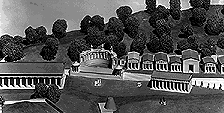Roman & Byzantine
(1st century BC - 4th century AD)
The economic and cultural revival along with the political stability felt in the
period of the Roman occupation marked a new phase in athletism,
internationalism. Following the extension of Roman citizenship to all inhabitants
of the Roman empire, athletes from many parts of the empire, Egyptians, Lykians,
etc, could participate and win to the Olympic games Extensive repairs to the Temple
of Zeus and other monuments took place under the auspices of the Emperors.

The new dedicated monuments and athletic facilities were erected at Olympia. The
Nympheum or Exedra was built by Herod Atticus in AD 150 in honor of his wife, Regilla.
It was a semi-circular structure with two small temples at the two ends of the
semi-circular rear wall. Statues of Antoninus Pius and Herod Attics were placed
in its 11 niches.
New Baths were built in AD 100 replacing the older Greek Baths and other bathing
facilities were installed in different parts of the site. An acqueduct was also
constructed by the emperor Hadrian in AD 160
In the 3rd century AD, Olympia suffered a number of strong earthquakes and many repairs
and restorations were needed. The invasions of barbarian tribes by AD 267,
devastated many cities of Greece. This led to the fortification of the central part
of the sanctuary by using demolished material from the site's monuments.
In the 4th century AD, major natural catastrophes caused the destruction of many
monuments. Despite the catastrophes, Olympiads continued to be held, as indicated
by the last victor's name, the Armenian prince Varasdat. In AD 393, the 293rd
Olympiad was held for the last time. In AD 393 Theodosius I, the Christian emperor
of the east Roman empire, forbade the Games.
The Altis was demolished In AD 426, as a result of a decree of Theodosius II.
The workshop of Pheidias was turned into a Basilica, and a Christian community
inhabited the site until the 6th century AD A new village was laid over the
ancient ruins, possibly destroyed by the Avars in the late 6th century. Following
these events, Olympia was buried under the alluvial deposits of the two rivers, until
its discovery by the archaeologists in the late 19th century.
Archaic and Geometric |
Classical |
Hellenistic
Back

